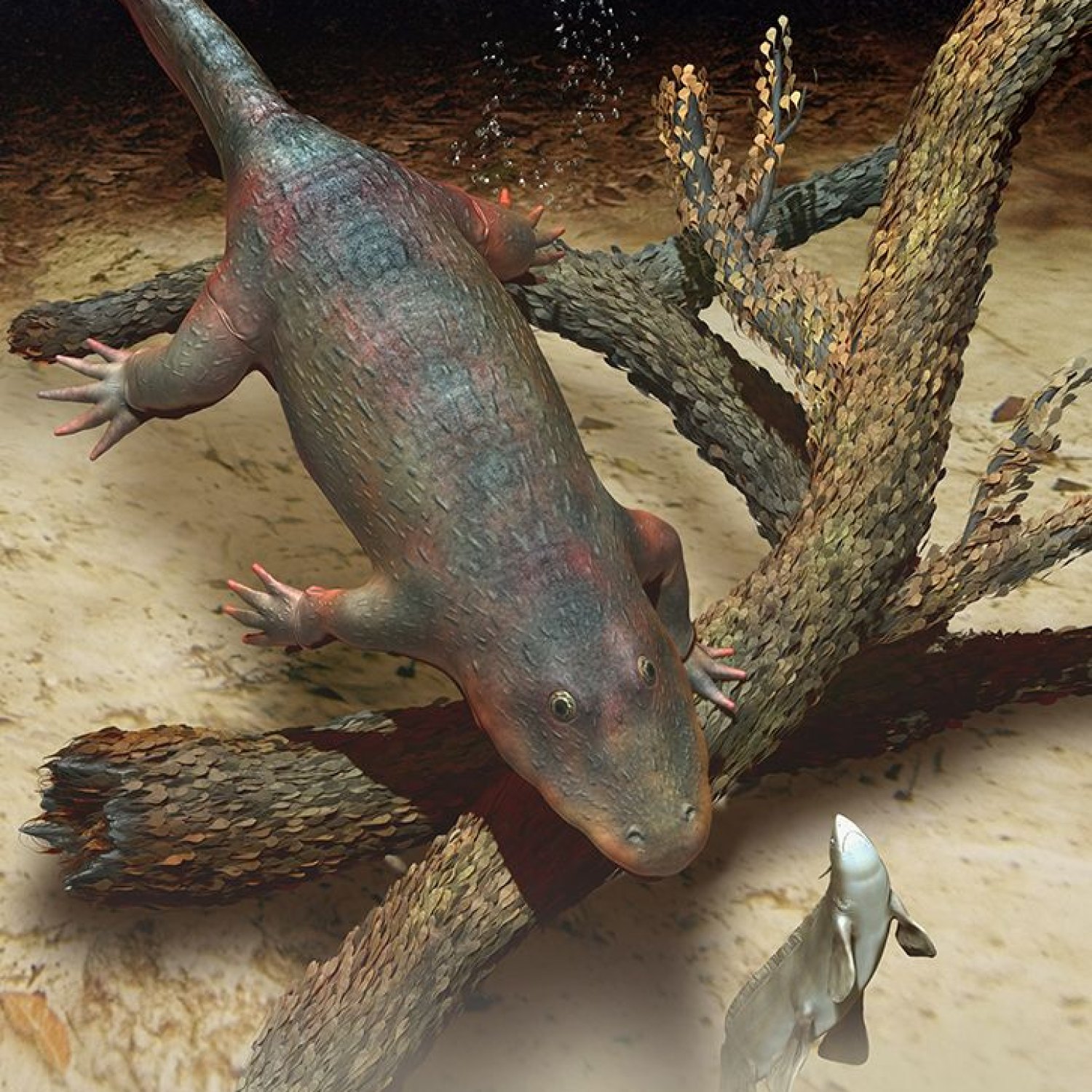
Xenacanthus
Up to 2 meters
Meet Xenacanthus, a prehistoric shark-like animal that roamed the lakes and rivers. This ancient creature could grow up to 2 meters long with an elongated and streamlined body. Belonging to the Xenacanthidae family, its name translates to strange spine. Although extinct, its fossils help scientists understand the evolution of modern sharks. #Xenacanthus #prehistoricshark #ancientcreature #fossilevolution
Animal Details Summary:
Common Name: Xenacanthus
Kingdom: Animalia
Habitat: Freshwater
The Ancient Predator: Xenacanthus
Xenacanthus is a prehistoric fish that roamed the Earth during the Carboniferous and Permian periods, about 358 to 290 million years ago. With an elongated and streamlined body shape, this ancient predator could grow up to 2 meters in length. Known for its unique features and dominance in the ancient waters, Xenacanthus has captured the interest of scientists and enthusiasts alike. Let's dive into the world of this fascinating creature and discover what makes it stand out from other prehistoric animals Xenacanthus.Scientific Classification
Before we delve into the details of Xenacanthus, let's first understand its scientific classification. Xenacanthus belongs to the Animalia kingdom, which includes all animals. It falls under the Phylum Chordata, meaning it has a dorsal nerve cord and a notochord, allowing for movement. It is classified under the Class Chondrichthyes, which comprises all cartilaginous fishes, including sharks, rays, and chimaeras. Xenacanthus is a part of the Order Xenacanthiformes and the Family Xenacanthidae.Habitat and Distribution
Xenacanthus was found in freshwater habitats, particularly in lakes and rivers, during the Carboniferous and Permian periods. These ancient waters were teeming with life, with Xenacanthus being one of the dominant predators. Scientists have discovered fossil remains of Xenacanthus in various locations worldwide, such as Europe, North America, South America, Africa, and Asia. This widespread distribution shows that Xenacanthus had a successful and diverse ecosystem to thrive in Xeme.Physical Description
One of the most striking features of Xenacanthus is its size. With a length of up to 2 meters, it was a formidable predator in the ancient waters. Its body shape was elongated and streamlined, allowing for efficient movement through the water. It had a dorsal fin that ran along its entire length and a pair of pectoral fins for steering. Its jaw was lined with sharp, pointed teeth, indicating its carnivorous feeding method.Coloration and Adaptations
The coloration of Xenacanthus varied, depending on the location and time period. Some fossils have shown pigmentation on their scales, indicating a dark coloration, while others have been found to be more translucent. This variance in coloration suggests that Xenacanthus had the ability to adapt to different environments and camouflage itself accordingly.Feeding and Behavior
Xenacanthus was a carnivorous fish, feeding on smaller fish and invertebrates in the freshwater habitats it inhabited. Its sharp teeth and streamlined body allowed it to swiftly catch its prey. Scientists also believe that Xenacanthus may have been able to breathe both underwater and on land, as some fossils have been found in mudflats. This adaptation would have allowed it to survive in times of drought when the water levels were low.Extinction
Despite its dominance in the ancient waters, Xenacanthus, along with many other species, eventually went extinct. The exact cause of its extinction is still debated, but it is believed to be a combination of factors, such as climate change, competition with other predators, and possible over-hunting by humans. However, fossils of Xenacanthus have been found in abundance, allowing scientists to gather information and gain insights into this ancient species' life.Role in Science and Research
Fossils of Xenacanthus have been crucial to researchers in understanding the ancient ecosystems and the Earth's past. By studying its physical features and behavior, scientists have been able to piece together a more comprehensive view of the Carboniferous and Permian periods, and the evolution of fishes. Additionally, as more fossils are discovered and analyzed, scientists can gain insights into the impact of environmental changes on species and how they adapt and survive.Xenacanthus in Popular Culture
Xenacanthus may have gone extinct millions of years ago, but its legacy continues to live on in popular culture. It has made appearances in various media forms, such as television shows, video games, and books. Its unique features and prehistoric allure make it a fascinating subject for many, and its role as an ancient predator has solidified its place in popular culture.In Conclusion
Xenacanthus may have been a prehistoric fish, but its legacy continues to captivate us today. Its prominent role in ancient waters, unique physical features, and widespread distribution make it a significant species in the Earth's history. By studying Xenacanthus and other prehistoric creatures, scientists can gain valuable insights into the evolution of life on our planet and how it has adapted to changes over time. And so, the legacy of Xenacanthus lives on, inspiring and fascinating future generations.

Xenacanthus
Animal Details Xenacanthus - Scientific Name: Xenacanthus
- Category: Animals X
- Scientific Name: Xenacanthus
- Common Name: Xenacanthus
- Kingdom: Animalia
- Phylum: Chordata
- Class: Chondrichthyes
- Order: Xenacanthiformes
- Family: Xenacanthidae
- Habitat: Freshwater
- Feeding Method: Carnivorous
- Geographical Distribution: Europe, North America, South America, Africa, and Asia
- Country of Origin: Multiple countries
- Location: Lakes and rivers
- Animal Coloration: Varies
- Body Shape: Elongated and streamlined
- Length: Up to 2 meters

Xenacanthus
- Adult Size: Large
- Average Lifespan: Unknown
- Reproduction: Sexual
- Reproductive Behavior: Unknown
- Sound or Call: Unknown
- Migration Pattern: Unknown
- Social Groups: Unknown
- Behavior: Unknown
- Threats: Extinct
- Conservation Status: Extinct
- Impact on Ecosystem: Unknown
- Human Use: None
- Distinctive Features: Distinctive fin spine on its back
- Interesting Facts: Xenacanthus existed during the late Paleozoic and early Mesozoic era
- Predator: Unknown

Xenacanthus
Discovering the Mysterious Xenacanthus: The Extinct Giant of Ancient Oceans
The world is full of fascinating creatures, both living and extinct. While many of us are familiar with the iconic dinosaurs that roamed the Earth millions of years ago, there are other fascinating creatures that have been lost in the depths of time. One such creature is the Xenacanthus, a mysterious and extinct aquatic predator that existed during the late Paleozoic and early Mesozoic era.Despite its size and unique features, the Xenacanthus remains largely unknown to the general public PeaceOfAnimals.Com. In this article, we will dive deep into the world of this ancient giant and uncover its distinctive features, behavior, and impact on the ecosystem.
A Giant Among Aquatic Predators
The Xenacanthus was a large creature, estimated to reach lengths of up to 5 meters and weighed around 200 kilograms. It is believed to have lived in freshwater habitats such as rivers and lakes, as well as shallow marine environments.With its enormous size, the Xenacanthus was undoubtedly one of the top predators of its time. Its sleek and agile body, along with its sharp and powerful teeth, made it a formidable hunter in the water. Despite its intimidating appearance, there is not much known about its behavior and reproductive habits.
A Mystery Enshrouded in Time
One of the most intriguing aspects of the Xenacanthus is the lack of information about its reproduction and behavior. While it is known that they reproduced sexually, their specific reproductive behaviors are still a mystery. Scientists speculate that they may have laid eggs like modern-day sharks, but there is not enough evidence to support this theory Xerus.Similarly, the social groups and migration patterns of Xenacanthus are still unknown. It is believed that they may have been solitary creatures or may have formed small groups to hunt and reproduce. Furthermore, their migration patterns remain a mystery, and it is unclear if they migrated in search of food or suitable breeding grounds.
A Distinctive Feature That Sets it Apart
One of the most notable and distinctive features of the Xenacanthus was its fin spine located on its back. This spine was unique to this species and helped differentiate it from other aquatic predators of its time. The fin spine was believed to be used for defense against other predators or as a display during courtship.The fin spine was not just for show; it also served a practical purpose. It contained sharp, serrated edges that could inflict severe injuries to any potential predators or prey. The Xenacanthus used its fin spine to its advantage, making it a dominant force in the ancient waters.
The Rise and Fall of the Xenacanthus
The Xenacanthus thrived during the late Paleozoic and early Mesozoic era, long before the existence of dinosaurs. It coexisted with other aquatic predators such as the huge Dunkleosteus and the smaller Coelacanth. However, the Xenacanthus was later driven to extinction due to reasons that are still unclear.Some theories suggest that a change in the environment may have caused the decline of the Xenacanthus. Others suggest that competition from other predators or even disease could have contributed to their extinction. Despite extensive research, the exact cause of their extinction remains a mystery.
A Lost Legacy
The Xenacanthus may be extinct, but its legacy lives on through the fossil records that have been discovered. Fossils have been found in various parts of the world, including North America, Europe, and Africa. These discoveries have given scientists a glimpse into the life of this ancient aquatic predator.Through the study of these fossils, scientists have been able to learn more about the physical characteristics and behavior of the Xenacanthus. However, there is still much to uncover about this mysterious creature, and every new discovery brings us closer to understanding its place in the ancient world.
Extinction and its Impact on the Ecosystem
The extinction of the Xenacanthus, like any other species, had an impact on the ecosystem. Being a top predator, the Xenacanthus played a crucial role in regulating the population of its prey species. Its extinction would have caused a ripple effect throughout the food chain, disrupting the balance of the ecosystem.It is also possible that the extinction of the Xenacanthus may have allowed for the rise of other aquatic predators, ultimately shaping the evolution of future species. However, without further research and evidence, it is difficult to determine the exact impact of their extinction on the ancient ecosystem.
In Conclusion
The Xenacanthus remains a fascinating and mysterious creature, with many aspects of its life still shrouded in mystery. Despite its extinction, it continues to captivate the minds of scientists and the general public alike. Its unique features, ancient presence, and unknown behavior make it a subject of endless curiosity and study.We hope that as we continue to uncover more about the Xenacanthus, we will gain a better understanding of this ancient giant and its place in the complex web of life on Earth. Until then, we can only marvel at this magnificent creature that once ruled the waters but now lives on only through the fossil remains that tell its story.

The Ancient Predator: Xenacanthus
Disclaimer: The content provided is for informational purposes only. We cannot guarantee the accuracy of the information on this page 100%. All information provided here may change without prior notice.












